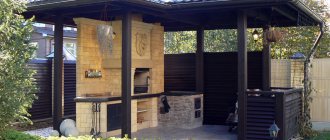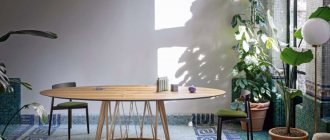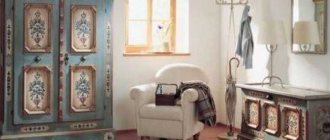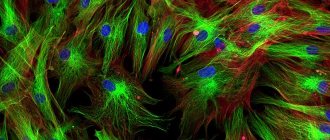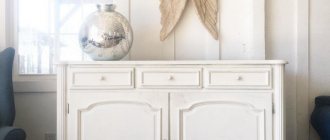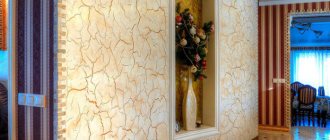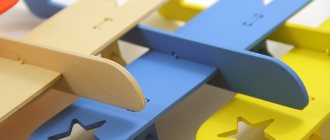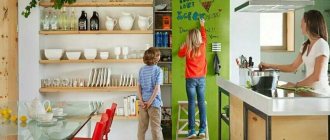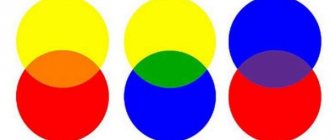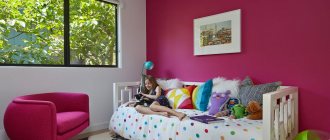Chalk paint is a godsend for the modern designer; it can be used to create the recently fashionable scuff marks on the surface of furniture, which look so colorful in romantic interiors in the Provence and shabby chic styles.
It has been known for many years and was previously used to paint walls and ceilings. Today, the popularity of such products has returned, however, their character and fate are completely different.
Nowadays, people increasingly want to buy chalk paints for furniture. They represent a new generation of products with a very wide range of applications. Most often they are used for furniture restoration, decorating fabrics and upholstery.
Chalk paint and its uses
This product can currently be found in the offer of many manufacturers. Paints can be purchased at hardware stores and supermarkets, or ordered online. Their main advantage is that they allow you to skip the painstaking preparation of the surface before the main coating. They are very easy to apply and the end results can be amazing.
The recent fashions of fading, shading and hand-painting are the basis of many interior design styles. However, chalk finishes have received the greatest recognition in interiors in the style of shabby chic (shabby chic), the meaning of which can be literally translated as a tired interior, worn out, but still chic. Inspiration from French and English country estates is very popular and is increasingly appearing in living rooms, bedrooms, kitchens, bathrooms and hallways. Furniture painted with chalk paint will help achieve the desired stylistic effects.
Chalk paints - characteristics
There are many types of chalk paints on the market, they differ from each other mainly in additives. All products of this type consist of chalk and water (in varying proportions). In addition, they may include:
- resins of synthetic or vegetable origin;
- silicates;
- casein;
- linseed oil.
Depending on the additives, resin paints, mineral paints, milk paints, oil paints and the like are distinguished.
When considering these options, it is difficult to separate the best and worst quality because it all depends on whether they are used properly and in accordance with their intended purpose. For example, for furniture that hasn't been used much, medium quality paint works well. However, already in the kitchen and bathroom, the coating must be resistant to moisture and variable temperatures.
A completely different type of paint will also be needed to cover varnished or varnished hardwood surfaces.
Coatings for decorating fabrics and upholstery will require another type of chalk paint.
Common features of all chalk compositions:
- good adhesion;
- dullness;
- fast drying time;
- environmental friendliness;
- do not cause allergies;
- simple preparation of the substrate.
Chalk paint - methods of application
In most cases, chalk paint is used to cover furniture. However, this group can also include products that can be used to coat not only wood and MDF, but also plastic, metal, leather and fabric. This is a very intriguing offer for people tired of worn-out upholstery or curtains.
Chalk paint for painting fabric
To paint fabrics and upholstery furniture with chalk paint, you need wax, which “covers” the finished surface and protects it from abrasion; in addition, it will protect the fabric from dirt. Coating fabric with such compositions is usually done with pleasure, and the work does not cause any problems. The paint perfectly covers smooth fabric, as well as structured and leather. It is better to cover structural fabric with a brush, because in this case the paint penetrates better into the recesses in the material. It is also important to saturate the fabric in advance, for example using a spray bottle.
Chalk compositions for decorating fabric are available in a fairly wide range of colors. The colors can also be combined with each other to create other shades. It is recommended to dilute the paint with water before application. The product is then applied in two layers at intervals of about 1 hour. After 24 hours you need to start waxing. Clear waxes can be applied using a brush or sponge. Thanks to them, the depth of the selected color becomes even more pronounced due to the effect of a polished surface.
Art painting of furniture
Such paints can also be used for hand-painting. They are great for decorating pieces of furniture, upholstery or plain curtains or blinds. With the right skills, the results can be very impressive.
Techniques for working with chalk paint. Part 1: contrasting painting of a dark surface white
The idea for this master class was born when, looking through many publications at the Crafts Fair, I realized that many people like to paint their old furniture white. To be honest, I’m not a big supporter of white furniture and shabby chic and French vintage styles, but here my research interest spurred me on, because... painting white is not the easiest technique, especially for beginners. I'm very passionate about working with chalk paint and love the almost unlimited creative possibilities it provides. I have already devoted two publications to working with chalk paint and, naturally, I could not ignore the topic of contrasting coloring of a very dark surface with white chalk paint.
First of all, I want to say why I recommend using chalk paint and not acrylic paint, which is used by the vast majority of home craftsmen. If you want to get a perfectly smooth and even surface without marks from a brush or roller, then chalk paint is the most convenient means of painting, because... It is very easy to apply, does not require priming and is easy to sand, unlike acrylic paint. But despite all the apparent ease and simplicity, if you do not take into account a certain coloring technology, then working with furniture from a hobby can turn into a hassle.
So, I will show the various nuances of painting using the example of an old interior door that I am preparing to throw away. This is glued fiberboard, corrugated cardboard inside, film outside. This is a standard inexpensive door, which sometimes begins to irritate us and we decide to modify it a little. A similar painting technique can be applied to other products.
Before painting, prepare the surface properly . Of course, chalk paint does not impose strict requirements on the surface, but if you do not notice a greasy stain, it will appear in all its “beauty.” The surface must be washed with detergent, can be wiped with a degreaser and dried.
Tools you will need:
1. Chalk paint. You can use homemade or store-bought chalk paint.
2. Brush. Keep in mind that any brush will still leave stroke marks. Keep in mind that bristle brushes leave a more noticeable texture than synthetic ones. If you want to get a decorative effect, then paint with a brush, but if you need a flat and smooth surface, then it is better to use a velor roller.
3. Velor roller. It gives a smooth surface and does not leave lint. In addition, paint consumption when working with a roller is half that of using a brush. It is advisable to take a new roller, then the surface will be smoother.
4. Container where you will apply the paint.
Painting technique using a roller. Apply paint to a dry, clean surface with a roller. First vertically, and then roll horizontally to distribute the paint more evenly. Make sure that the roller is always slightly damp, because... chalk paint dries very quickly and whole clumps will be torn out of a dry roller.
After applying the first layer, wait for it to dry. On average, good chalk paint takes 10 to 30 minutes to dry, depending on air humidity.
After the first layer has dried, lightly level the surface with a soft sanding sponge (500-1000). Brush off the dust with a dry brush or cloth, or blow it with a hairdryer.
Then apply the second layer in the same way. Dry it. Typically, when applying paint this way, it takes me about 47 ml/sq.m for two layers. With a brush, the consumption is about 50-100 ml/sq.m for two layers (especially when making a textured surface, apply a thicker layer of paint).
However, here the first pitfall was discovered - in order to paint a dark surface white, you need to apply 5 layers of chalk paint with a roller. This is what happened after applying the fourth layer, the dark surface is a little translucent:
If the color of the surface and the color of the paint are similar in brightness or shade, then two layers of paint are sufficient. Here is a clear example on the same door. If you paint it a cappuccino shade, then two coats of my chalk paint is enough to get an evenly colored surface.
Of course, for those who use homemade chalk paint there are no big problems - you can apply as many layers of paint as necessary until the perfect result. And if you buy paint, then this is a significant waste. Let's try the second method of painting - using a brush.
Painting technique using a brush. We also apply paint to a clean surface with a brush. Dry and sand in the same way as when painting with a roller.
After applying 4 layers the result was the following:
The result is better, but not ideal; a fifth coat of white paint is still required. The main problem is the uneven application of paint to the surface, especially if you are painting a large area - a door, a cabinet, etc. When painting by hand, it is impossible to apply the paint absolutely evenly; dark “bald spots” still remain and you have to apply another layer of paint. I keep thinking about the economical use of chalk paint. After thinking a little, I came to the conclusion that in this case, soil would be appropriate. It increases adhesion and covers up the dark color, so much less chalk paint should go away.
Technique of contrasting coloring using primer. I will dwell on this technique in more detail, because... It seems to me the most optimal. For priming, you can use any white acrylic primer available to you. When purchasing, read carefully the composition and purpose of the primer; it varies depending on the characteristics of the surface. We apply the primer with a roller.
The soil lays down very thinly and coveringly. After two coats it was possible to apply chalk paint, but I decided to add a control third coat. Here's the result:
After the primer has dried, it must be leveled with a sanding sponge. Next, we apply chalk paint in the following way: apply the paint with a brush and roll it out with a roller to get a more uniform coating.
After this application, only two layers of chalk paint were enough to obtain an even white coating. Thus, we obtain a perfectly smooth white surface without much difficulty and at minimal cost.
After final drying and sanding, we coat the door with water-based acrylic parquet or acrylic-urethane varnish. Can be done with a brush or roller. It is better to take a new roller, then you will get an even, smooth coating. After the first layer of varnish has dried (after 24 hours), lightly sand the surface to even out the varnish layer, remove dust and apply the second layer. The number of layers of varnish depends on its quality, wear resistance and the intensity of use of the door. It should also be taken into account that the polymerization and hardening of paint and varnish lasts for several more days. Therefore, after painting and varnishing the surface, it is best not to touch it for several days, then the coating will be very durable.
There are many methods of coloring, I only talked about one of them. Don't judge too harshly if you didn't see the finished, repainted white door. I don’t like white in the interior and I’m just experimenting with my old monster before my husband throws the door in the trash. I have it all in multi-colored “rags”, so I won’t show my ugliness.
If you have your own experience of painting a surface white, or some other, perhaps more professional, techniques, please share. The more we know, the better we will do next time. I hope that my publication will help all lovers of white furniture.
Facts and myths about chalk paint
Manufacturers often write on the packaging of their products that there is no need to prepare the surface (putty, remove old paint, etc.), and a beautiful surface coating is obtained by applying two layers. This information must be viewed critically because it is not always confirmed in practice. Some preparation of the substrate is still needed. Of course, the surface must be cleaned and degreased. This can be done with water and household detergent (such as dishwashing liquid). The best results will be obtained by using painter's soap or gasoline.
It is also obvious that if there are defects on the surface of the furniture, then they need to be puttied. If this is not done, they will be visible to the freshly painted surface. Miracles, unfortunately, do not exist in this regard.
Chalk paints are ideal for achieving aging, abrasion and other similar stylization effects. For these purposes, sometimes it is enough to apply one layer of the product. However, complete opacity is a completely different matter and depends primarily on the type and condition of previous coatings. In fact, two layers do not always give a satisfactory effect, and it happens that a third or even a fourth layer needs to be applied.
How is chalk paint different from other paints?
photo: flickr / Lidia Navarro Cuenca
Besides the matte finish, chalk paint differs from traditional paint in several other ways. One of its obvious advantages is that it does not require any preparatory work. You can use paint on most clean, dry surfaces (except metal or shiny laminate), even if they are already painted. For this reason, DIYers love to coat antique items that have cracks or raised parts with chalk paint, as the paint adheres easily even to uneven surfaces. Plus, because of its consistency, you're less likely to stain your surroundings than if you used the regular version. Plus, chalk paint is water-based, so you can clean your brushes with soap and water instead of using harsher cleaners.
DIY chalk paint for furniture
Each of us knows the value of chalk paint. But you can do it yourself. How to make chalk paint for furniture? It is not difficult!
Composition of chalk paint for furniture:
- water;
- dental plaster;
- jar;
- a small diameter stirrer that will fit into the jar;
- any acrylic paint (not to be confused with acrylic emulsion);
- spoon.
Chalk Paint Recipe for Furniture
- Pour gypsum into a vessel of any container (you can take a liter jar) to 1/3 of the volume.
- Carefully add water, mixing thoroughly with a spoon so that there are no lumps. The mass should be thick, thicker than thick sour cream. You can also mix with a stirrer.
- Pour acrylic paint to the top. Mix again, collecting all traces of gypsum from the sides of the jar, stirring all the lumps. This time, the consistency should be like thick sour cream with 30% fat content.
Before use, it is worth conducting a test on a small, inconspicuous area of furniture.
Making your own chalk dye
Preparing chalk CM at home is not difficult, the procedure saves money.
There are several recipes for creating a slate-effect coating. The main component of each is acrylic dye. The location where the CM will be applied (outdoors or indoors) is taken into account. Facade acrylic is selected for outdoor work and another composition for painting inside house construction.
First recipe
Components:
- acrylic – 200 grams;
- cement - 2 tbsp. l.
Pure cement or its mixture is mixed with the second component.
Second recipe
Components:
- acrylic – 3 parts;
- matte acrylic varnish – 1 part;
- cement (putty or grout) – 1 part;
- water – 1 part.
Small areas are painted with dye.
Third recipe
Components:
- acrylic KM - 2/3 parts;
- baking soda – 1/3 part;
- water.
The components are mixed to the desired consistency.
If soda is replaced with starch, the volume of water increases. The rest of the proportionality remains the same.
KM, which is considered the best:
- acrylic – 2/3 parts;
- chalk powder – 1/3 part;
- water for the desired viscosity.
The coating applies evenly, is applied to a base of any material, and does not need to be sanded.
Another simple recipe:
- Construction plaster is added to acrylic in a proportion of 3:1.
For wall cladding, a composition with metal filings and quartz sand is recommended. The result will be a velvet coating.
